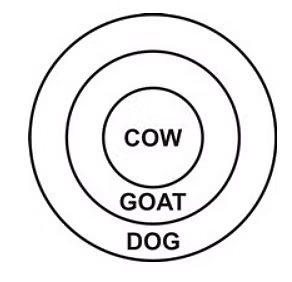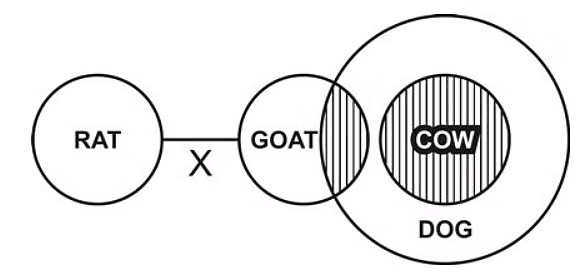Syllogism Based Questions | General Aptitude for GATE - Mechanical Engineering PDF Download
| Table of contents |

|
| Syllogism |

|
| Shortcut Tricks |

|
| Solved Examples |

|
| Possibility |

|
Syllogism
Syllogism is a key chapter in verbal reasoning that plays a vital role in enhancing logical thinking. It is commonly included in various competitive exams to evaluate a candidate’s logical ability.
These questions are best solved using Venn diagrams, which help visually represent the relationship between different statements. Drawing an accurate Venn diagram based on the given statements makes it easier to reach the correct conclusion.

Syllogism questions usually involve two types of conclusions: definite conclusions and possible conclusions. Each type may require different Venn diagram representations.
Before evaluating the conclusions, it's important to first draw a basic Venn diagram according to the statements. This step simplifies the process and makes it easier to identify valid conclusions.
Shortcut Tricks
Some shortcut tricks will help you solve it simply and also take less time to solve questions
The following given cases have the respective Venn diagram which will help in solving questions of such kind
- All DOGS are CATS
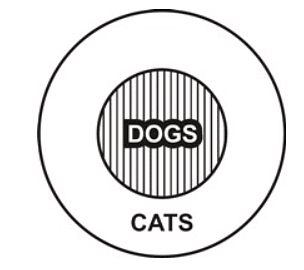
- Some DOGS are CATS

- No DOG is CATS
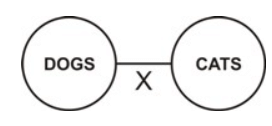
- Some DOGS are not CATS
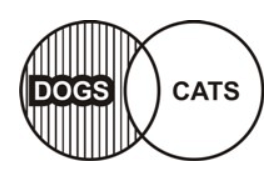
Solved Examples
- In each of the questions below, two statements are followed by two conclusions numbered 1 and 2.
- You have to consider the two given statements to be true even if they seem to be at variance from commonly known facts and choose the correct option about conclusions which logically follows from the two given statements.
(a)only conclusion i follow
(b)only conclusion ii follow
(c)either i or ii follows.
(d)neither i nor ii follows.
(e)both i or ii follows.
Example 1: Statements:
- All cows are goat
- All goat are dog
Conclusions:
- All cows are dog
- Some cows are dog
Ans: (e)
Explanation:
Conclusion 1: "All cows are dogs."
- Since all cows are goats (from Statement 1) and all goats are dogs (from Statement 2), it logically follows that all cows must be dogs. This conclusion is true.
Conclusion 2: "Some cows are dogs."
- If all cows are dogs (as derived from Conclusion 1), then it's also true that some cows are dogs. This conclusion is also true because "some" is a subset of "all."
Therefore, Conclusion i and ii follows.
Example 2: Statements:
- All cows are dogs
- Some dogs are goat
- No goats are rat
Conclusions:
- Some rats are cows
- No rats are cows
Ans: (b)
Some rats are cows.
- Explanation:
- Given: All cows are dogs (All Cows → Dogs).
- Some dogs are goats (Some Dogs ↔ Goats), and no goats are rats (No Goats ↔ Rats).
- Inference: Since only some dogs are goats, there are dogs (including cows) that are not goats. Therefore, it's possible for some cows to be outside the goat category and potentially be rats.
- Verdict:Possible.
No rats are cows.
- Explanation:
- Given: All cows are dogs, and no goats are rats.
- Inference: It's also possible that all cows (which are dogs) are entirely separate from the rat category. Since the statements do not establish a direct relationship between cows and rats, cows can be exclusively non-rat dogs.
- Verdict:Possible.
Hence both i and ii are possible.
Possibility
In syllogism, possibility refers to a type of conclusion where you need to check whether a given scenario can be true, based on the provided statements. To verify such conclusions, you must draw appropriate Venn diagrams that represent the given statements accurately and then evaluate whether the conclusion is logically possible.
Note: While checking a possibility-based conclusion, you should draw a Venn diagram that satisfies both the statements and the possibility, ensuring the original conditions are not violated.
Sometimes, these conclusions are presented in a positive or negative form.
Example: Statements:
- All books are pen
- Some pen are pencil
- No pencil is Eraser
Conclusions:
- All books being Eraser is possibility
- Some books being Eraser possibility
Ans: (d)
All books being erasers is a possibility.
- Explanation: Since all books are pens, and some pens are pencils, but no pencils are erasers, it is possible for books (which are pens) to be erasers as long as they are not among the pens that are pencils. There is no statement preventing all books from being erasers.
Some books being erasers is a possibility.
- Explanation: Even if not all books are erasers, the fact that some pens are not pencils allows for the possibility that some of these pens (which are books) could be erasers without violating any of the given statements.
|
229 videos|191 docs|158 tests
|
FAQs on Syllogism Based Questions - General Aptitude for GATE - Mechanical Engineering
| 1. What is a syllogism and how is it used in logical reasoning? |  |
| 2. What are some shortcut tricks to solve syllogism questions quickly? |  |
| 3. Can you provide an example of a syllogism question and its solution? |  |
| 4. How do possibility syllogism questions differ from standard syllogism questions? |  |
| 5. What are some common mistakes to avoid when solving syllogism questions in exams? |  |

